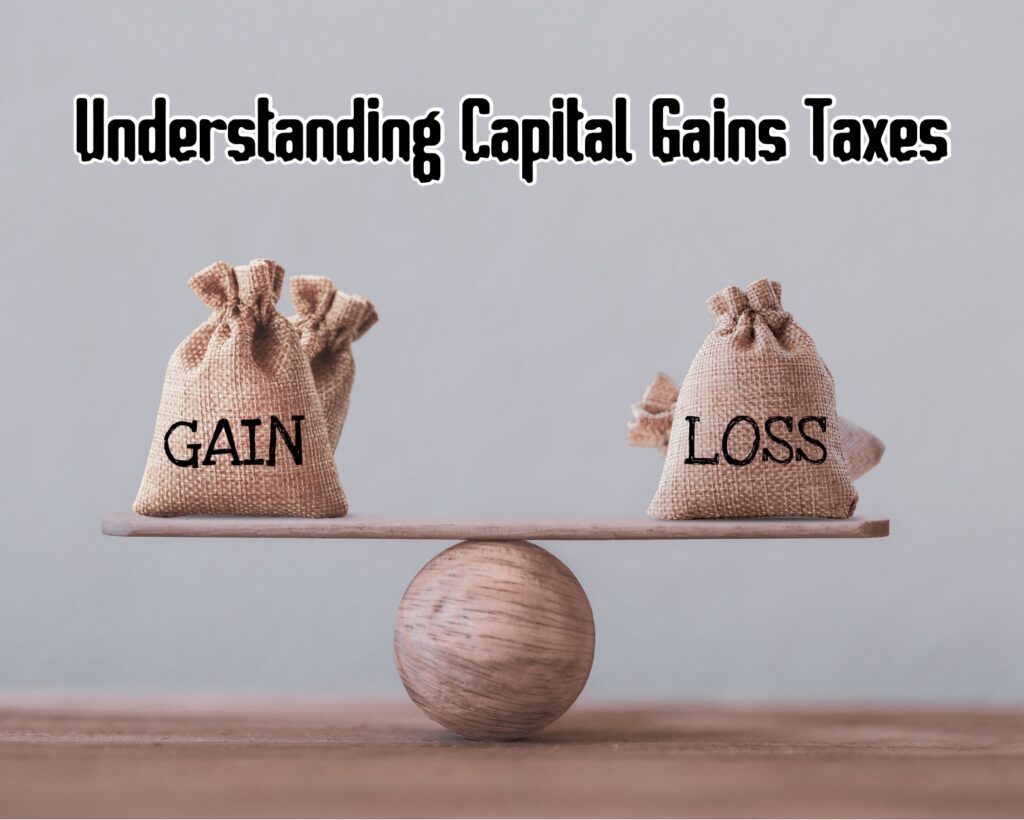Capital gains taxes are a crucial aspect of financial planning and investment strategy. They are taxes levied on the profit made from selling an asset, such as stocks, bonds, real estate, or business interests. Understanding how these taxes work is essential for anyone looking to make informed investment decisions.

What Are Capital Gains Taxes?
Capital gains taxes are applied to the difference between the purchase price (cost basis) and the selling price of an asset. These taxes are categorized into two types: short-term and long-term.
Short-Term Capital Gains
- Definition: Gains on assets held for one year or less.
- Tax Rate: Taxed at the same rate as your regular income.
Long-Term Capital Gains
- Definition: Gains on assets held for more than one year.
- Tax Rate: Typically lower than short-term rates, varying based on income level.
How Are Capital Gains Calculated?
To calculate capital gains, subtract the purchase price of the asset from the selling price. If the result is positive, it’s a gain; if negative, it’s a loss.
Example Calculation
- Purchase Price: $10,000
- Selling Price: $15,000
- Capital Gain: $15,000 – $10,000 = $5,000
Tax Rates and Brackets
The tax rate for capital gains depends on your taxable income and filing status. Long-term capital gains tax rates are generally more favorable, ranging from 0% to 20%.
Exemptions and Deductions
Certain exemptions and deductions can reduce capital gains tax liability. For example, the first $250,000 ($500,000 for married couples) of gain on the sale of a primary residence is often exempt.
Reporting Capital Gains
Capital gains must be reported on your tax return using Schedule D and Form 8949. Accurate record-keeping is essential to report gains and losses correctly.
Strategies for Minimizing Capital Gains Taxes
- Hold Investments Long-Term: Holding assets for more than a year can qualify them for lower long-term capital gains rates.
- Tax-Loss Harvesting: Selling assets at a loss can offset gains and reduce tax liability.
- Utilize Tax-Advantaged Accounts: Investing through IRAs or 401(k)s can defer or eliminate capital gains taxes.
Legal and Tax Advice
For more detailed information on laws and tax regulations, including capital gains taxes, visit 🌟 LegalKnowItAll.com 🌟. This resource offers a wealth of knowledge on various legal and tax-related topics.
Capital gains taxes are an important consideration for investors and taxpayers. Understanding how these taxes work, how they are calculated, and what strategies can minimize their impact is crucial for effective financial planning. For further legal and tax insights, don’t hesitate to explore 🌟 LegalKnowItAll.com 🌟 for comprehensive information and guidance.
Strategies to Avoid or Reduce Capital Gains Taxes
While it’s not always possible to completely avoid capital gains taxes, there are several strategies that can help minimize their impact. These tactics require careful planning and consideration of your overall financial situation.
1. Utilize Tax-Advantaged Accounts
- Retirement Accounts: Investing in retirement accounts like IRAs or 401(k)s can defer or eliminate capital gains taxes. In these accounts, investments can grow tax-free or tax-deferred.
- Education Savings Accounts: 529 plans or Coverdell Education Savings Accounts offer tax-free growth and withdrawals for qualified educational expenses.
2. Hold Investments for the Long Term
- By holding assets for more than a year, they qualify for the lower long-term capital gains tax rates. This simple strategy can significantly reduce the tax burden.
3. Offset Gains with Capital Losses
- Tax-Loss Harvesting: This involves selling investments at a loss to offset gains. It’s a common strategy used to manage tax liability, especially in volatile markets.
- Carryover Losses: If your losses exceed your gains, you can carry over the loss to offset gains in future years.
4. Invest in Opportunity Zones
- Investing in designated Opportunity Zones can defer and potentially reduce capital gains taxes. There are specific rules and timelines to follow for this benefit.
5. Gift Assets to Family Members
- Gifting assets to family members in lower tax brackets can reduce the overall capital gains tax burden. However, be aware of gift tax rules and limits.
6. Charitable Contributions
- Donating appreciated assets to charity can avoid capital gains taxes and provide a charitable deduction. This is a win-win for both the taxpayer and the charity.
7. Real Estate Exclusions
- For primary residences, you can exclude up to $250,000 ($500,000 for married couples) of capital gains from taxes. This applies if you’ve lived in the home for at least two of the last five years.
8. Consider a 1031 Exchange for Real Estate
- A 1031 exchange allows you to defer capital gains taxes by reinvesting the proceeds from a real estate sale into another property.
9. Monitor Your Tax Bracket
- Capital gains tax rates are dependent on your overall taxable income. Sometimes, strategic income planning can keep you in a lower tax bracket, reducing your capital gains tax rate.
10. Seek Professional Advice
- Tax laws can be complex and ever-changing. It’s advisable to consult with a tax professional or financial advisor to understand the best strategies for your situation. For more detailed legal and tax advice, visit 🌟 LegalKnowItAll.com 🌟.
Remember, while minimizing taxes is a smart financial strategy, it should be balanced with your overall investment goals and financial health. Each decision should be part of a well-thought-out financial plan. For more insights into navigating the complexities of capital gains taxes and other financial matters, 🌟 LegalKnowItAll.com 🌟 is an excellent resource.



